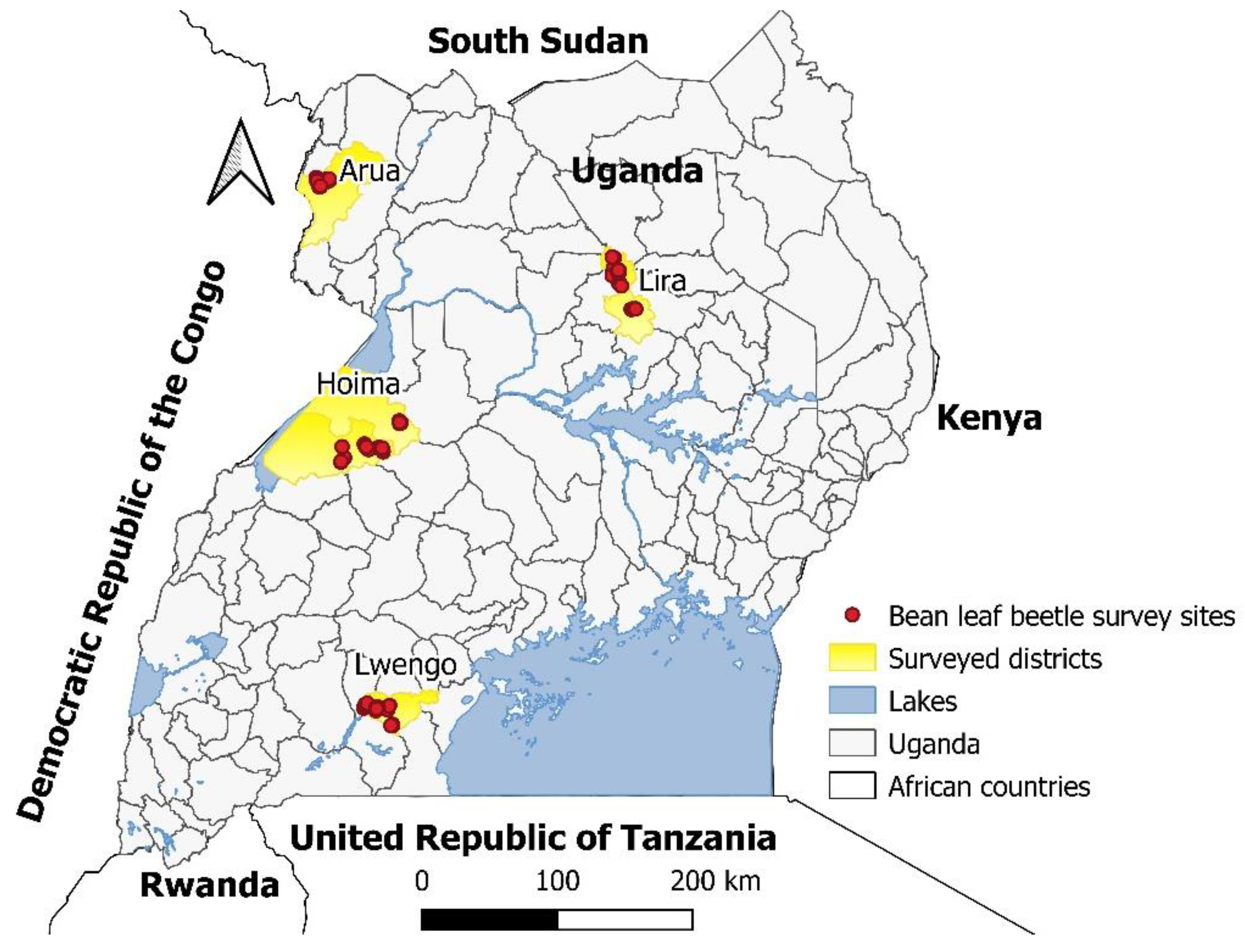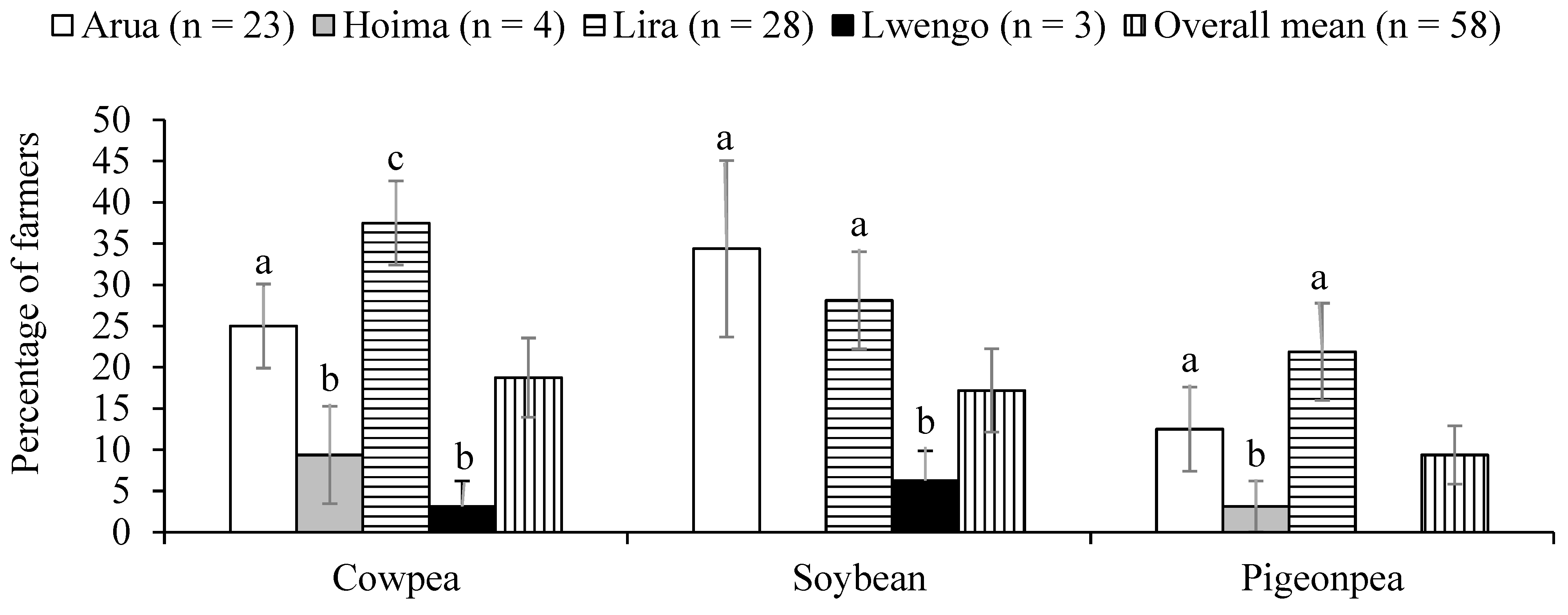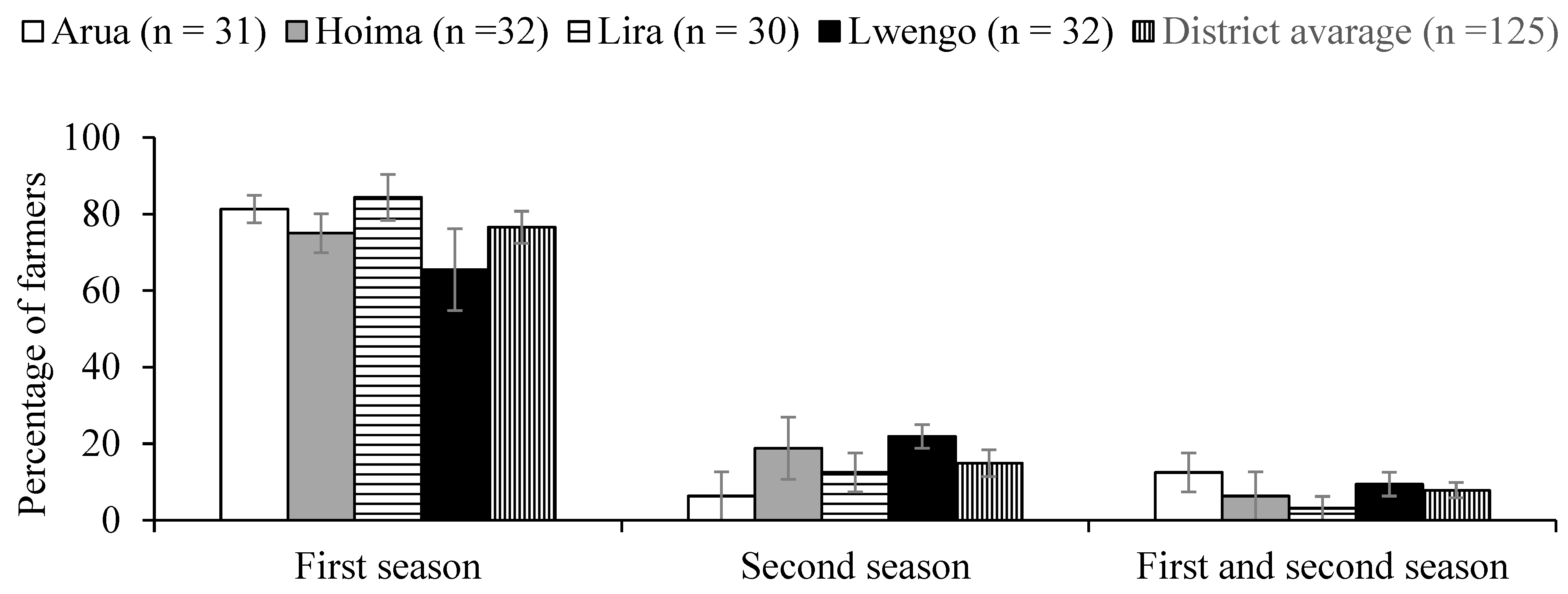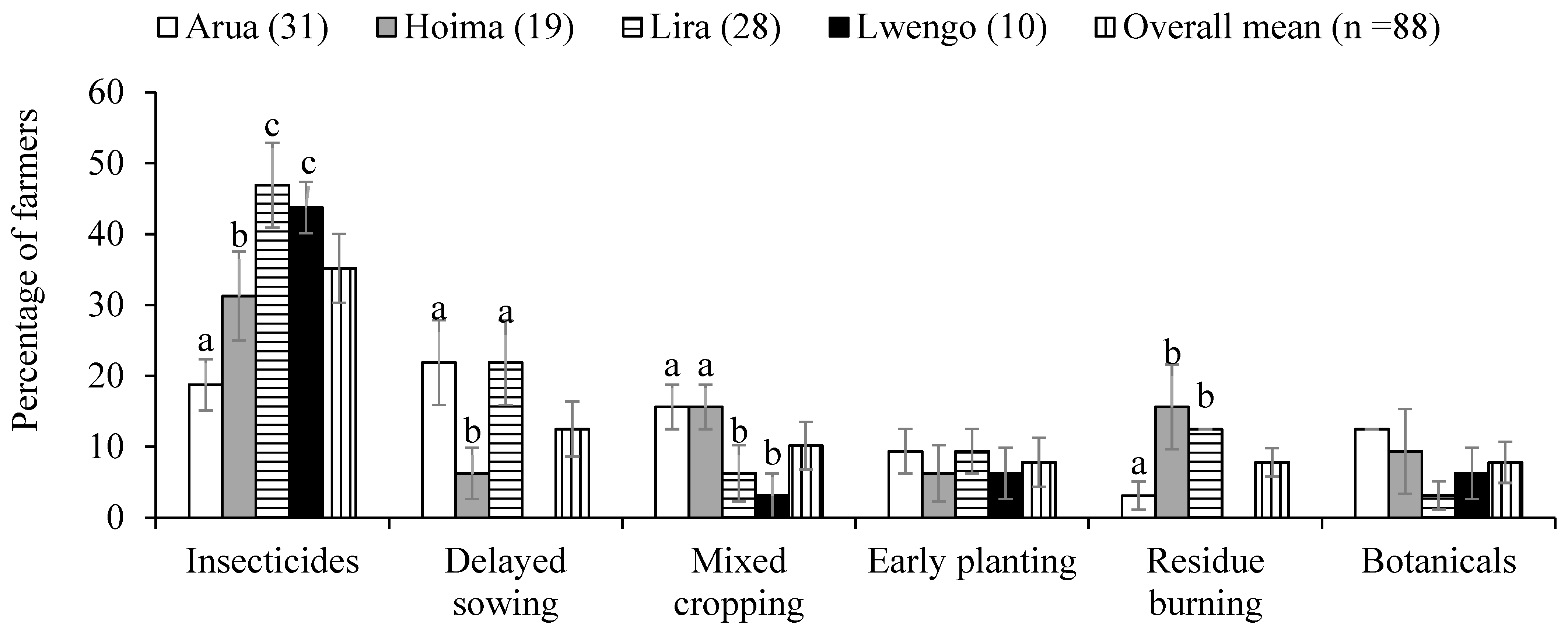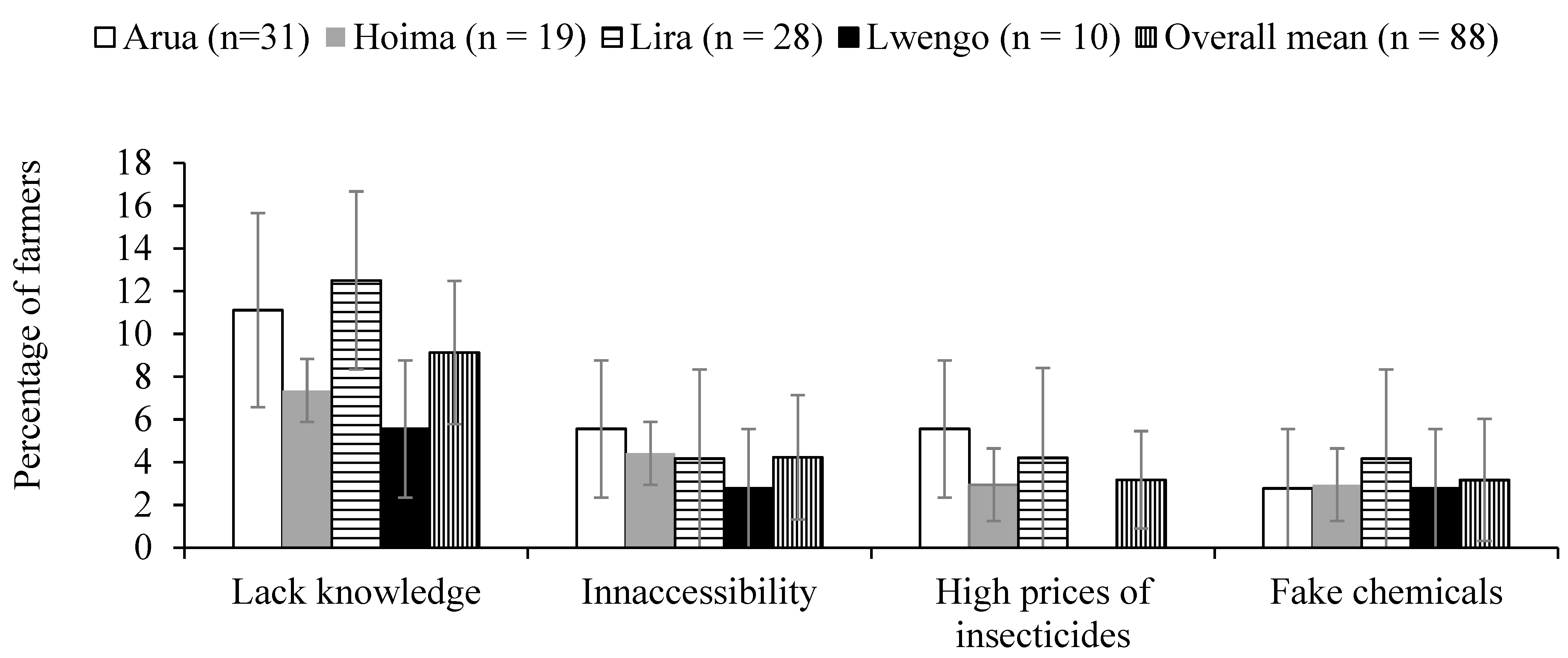1. Introduction
The common bean (
Phaseolus vulgaris L.) is one of the key pulses grown by about 54% of farmers in Uganda, with an annual production of approximately 707,000 metric tons (MT) [
1]. In Uganda, the expected yield of common bean is 2.5–3.5 MT/ha, far higher than the realised yield of 0.6–0.8 MT/ha [
2,
3]. The low production and productivity of the common bean in Uganda is due to many factors, including biotic (pests, diseases, and weeds), abiotic (water stress and declining soil fertility), and socio-economic constraints (limited extension services and poor quality seed) [
4,
5]. Bean leaf beetles (BLBs) are among the important field insect pests of common beans in Uganda and East Africa at large [
6,
7].
Ootheca mutabilis Sahl,
O. proteus Chapius,
O. orientalis W., and
O. ugandae Kortenhaus & Wagner sp. n. have all been found in Uganda’s various agroecological zones [
8].
Bean leaf beetles feed on several leguminous crops, including cowpea (
Vigna unguiculata L.), soybean (
Glycine max L.), pigeon pea (
Cajanus cajan L.), members of the hibiscus family (
Hibiscus spp.), and okra (
Abelmoschus esculentus L.) [
9]. The BLBs attack roots, leaves, flowers and pods of leguminous crops, causing severe damage to seedlings. The damage may persist through to the post-flowering stages. Yield loss of common bean to BLB infestations in Uganda is estimated at 48.9% [
10].
Smallholder farmers dominate crop production in Africa, and they frequently rely on self-learning of techniques to manage field and storage pests [
11]. Although several methods have been proposed for the control of BLBs in Uganda, designing and implementing an efficient Integrated Pest Management (IPM) programme for these pests is complicated by a lack of information on farmers’ knowledge, perceptions, control methods, and pest management constraints [
7]. The collection and comprehension of existing farmers’ knowledge of the pest, control methods, and obstacles, are required for the development of sustainable pest control approaches. Farmers’ knowledge, perceptions and practices are known to fluctuate within and between places [
2,
12,
13]. These differences could be related to the identification of the pest, perception of pest impact, management practices, and constraints influenced by agroecological or socio-economic factors. In developing an IPM program for smallholder bean farmers in common bean-growing countries like Uganda, data concerning existing farmers’ knowledge, management methods, and obstacles experienced in managing BLBs are critical. The goal of this study was to analyse existing farmers’ knowledge of BLBs, control strategies with their perceived effectiveness, and challenges to management, to help build a participatory IPM strategy against these pests in Uganda.
4. Discussion
The purpose of this survey was to examine farmers’ current knowledge of BLBs, control measures, and challenges in managing these beetles in Uganda. The survey was carried out in four districts, each of which was chosen from one of the four agroecological zones where the common bean is a staple food. The survey indicated that there were more male than female respondents. This could be attributed to the fact that in many African societies, men are usually quicker to talk to interviewers or visitors than women in rural settings [
21]. Knowledge and perception studies where males outnumber females have been previously reported in Tanzania, Benin, and Uganda [
17,
22,
23]. This implies that deliberate efforts must be made to include women in the development and application of strategies for managing BLBs in the surveyed districts. Astonishingly, the number of years of formal education did not influence farmers’ knowledge of BLBs, control measures, and the challenges in managing these pests. This is contrary to the assertion that farmers who have attained more than seven years in school are more literate and knowledgeable about pests and diseases of crops and their management than those with seven or fewer years of formal education [
17,
24]. This may imply that farmers learn about BLBs through experience-sharing with fellow farmers, especially in the case of endemic pests. Certainly, informal farmer-to-farmer interactions remain important information-sharing channels on plant agronomies in Africa [
11,
25]. Therefore, the development and implementation of an IPM programme for BLBs must involve all common bean farmers, regardless of education level.
Unlike Hoima and Lwengo, most farmers in Arua and Lira could recognize BLBs and gave them local names; they also knew that adult beetles damage leaves of the common bean. The damage caused by premature stages of BLBs were least-known in all the study districts. In Northern and Eastern Uganda, BLBs have been reported as major common bean pests since the 1990s [
10,
26,
27]. This is corroborated by UNDP [
3] and Halerimana et al. [
10] during biological monitoring surveys, which found a higher number of BLBs in Northern and Eastern Uganda than in Central and Western Uganda. Halerimana et al. [
10] reported three species of BLBs belonging to the genus
Ootheca (i.e.,
O. mutabilis,
O. proteus, and
O. orientalis) in the four agroecological zones (West Nile Farmlands, Northern Moist Farmlands, Western Masaka-Mityana Farmlands, and Central Wooden Savannah) in Uganda. Whereas
O. mutabilis is present in all four agroecological zones,
O. proteus is reported in Northern Moist Farmlands, West Nile Farmlands, and Central Wooden Savannah;
O. orientalis is only present in Central Wooden Savannah.
Farmers get acquainted with the pest which stays longer in an area and also share knowledge on locally available control measures. Wilhelmina et al. [
28] emphasize that farmers’ learning and knowledge-sharing are important factors that influence how they view and generate local solutions to pest problems. This supports the findings of our survey, as many farmers in Lira and Arua districts were able to identify BLBs to the extent of mentioning coined local names for the pests. A limited number of farmers were aware that BLBs oviposit (lay eggs), diapause, then emerge from the soil. Ampofo and Massomo [
29] had similar findings for
O. bennigseni in Tanzania. It implies that farmers are unable to link the earliest signs of BLB damage (wilting and premature senescence) to bean plants due to lack of information, and hence fail to take a timely action against the pests [
6,
30]. To bridge the existing knowledge gaps (about the biology and ecology of BLBs) among common bean farmers, our findings will be extended to the respective ZARDI researchers who participated in the survey. The ZARDI researchers will pass on the findings to common bean farmers and extensionists as part of the process to enhance the proper management of BLBs.
The majority of farmers were aware of alternate host crops (mainly cowpea, soybean, and pigeon pea) for BLBs, with a higher percentage of farmers in Arua and Lira noting cowpea and soybean than in Hoima and Lwengo. Our findings are supported by earlier reports that BLBs are native African cowpea pests that have evolved to feed on various leguminous crops [
6,
31,
32]. Northern Uganda has more known host crops than Central and Western Uganda, which could explain the high prevalence and damage caused by BLBs. This suggests that specific BLB control techniques for Arua and Lira must be developed to manage the pests across a variety of host plants. The perceived magnitude of BLB infestation as minor in Lwengo, moderate in Hoima, and severe in Arua and Lira shows that BLBs are of trivial importance in Lwengo. This is consistent with the reports by Kyamanywa et al. [
27] and Halerimana et al. [
10], who reported Northern and Eastern Uganda as the regions most-affected by BLBs. The prevailing ecological and biological factors have been pinpointed for the disparities in BLB damage [
6,
32]. Indeed, according to Halerimana et al. [
10], the high prevalence of BLBs in Northern and Eastern Uganda is due to the abundance of host plants and favourable climatic conditions.
The farmers’ perception that a high abundance of BLBs occurs during the first crop-growing season is in line with the findings by Kyamanywa et al. [
27]. Mwanauta et al. [
30] attributed the appearance of BLBs in the first crop-growing season to the obligatory diapause of teneral adults before and after the first season. As a result, teneral adults always emerge at the start of the first season and begin feeding on the leaves of newly planted common beans. Farmers’ knowledge of the seasonal abundance of BLBs can be used to educate them on tillage practices, such as ploughing before and after the first season to reduce pest attacks. Ploughing buries larvae and pupae into the soil where they cannot emerge, or exposes them to natural enemies and adverse weather conditions [
9].
Belonging to a particular district, membership in farmer organizations, and years of experience in cultivating beans were all positive drivers of farmers’ knowledge of BLBs, while the male gender and receiving agricultural advisory services on the common bean were negative predictors. Farmers’ knowledge varying by location indicates that BLBs have a varying bearing depending on the study region, and hence farmers who face their severe impact are more aware of them. Our findings revealed that more farmers in West Nile Farmlands and Northern Moist Farmlands (Arua and Lira districts of Northern Uganda, respectively) are more aware of BLBs than their counterparts in Western Masaka-Mityana Farmlands and Central Wooden Savannah (Lwengo and Hoima districts of Central and Western Uganda, respectively). This finding supports that of Halerimana et al. [
10] that BLBs are known field insect pests of the common bean in many districts of Northern Uganda. This indicates the need for prioritisation of BLB control interventions in Arua and Lira districts over other common bean-growing areas. The positive correlation of being a member of a farmer organization and knowledge of BLBs indicates that interactions among farmers expose them to information about bean pests. This is supported by the report by Mendesil et al. [
11] that belonging to farmer organizations gave opportunities for Ethiopian farmers to exchange crop management information. Bean farmer organizations in Uganda would therefore provide a platform for farmer engagement in the development and promotion of cost-effective BLB control techniques. Our data showed that the duration of experience of growing the common bean influenced farmers’ knowledge of BLBs. This is supported by the report by Van Mele and Van Chien [
25] that the life-long experience of growing a crop, gained through regular observations and information exchange, enables the farmers to understand pests that affect it. Farmers with more experience in common bean growing would be key in promoting awareness of BLBs among fellow farmers with less experience. The experienced farmers would participate in the development and championing of strategies for managing the pests.
The fact that the male gender is a negative predictor of farmers’ awareness of BLBs could be due to the distinct tasks performed by men and women in bean gardens, as previously noted by UNDP [
3]. Indeed, because of the critical responsibilities women play in its production, the common bean was once associated with women [
33] and referred to as a woman’s crop. As a result of their experience with continuous common bean cultivation, women are more familiar with bean farming than men [
21]. Our findings are similar to those of Khan et al. [
34], who found that knowledge of the Napier stunt disease was negatively associated with the male gender in Kenya. However, for men and women, working together in bean growing would lead to the successful management of BLBs, as both will be sharing knowledge about these pests and probable control tactics. Surprisingly, receiving advisory services was also a negative predictor of farmers’ understanding of BLBs. This could indicate that the advice provided by extension service personnel was either insufficient or not customized to BLBs. It is worth noting that crop production in Uganda is hampered by outdated agricultural extension information that is not responsive to farmers’ requirements, as well as insufficient research and results dissemination on crop pests [
35]. This necessitates the updating of information packages as well as the retraining of extension workers in Uganda in the biology, ecology, and control of pests of common beans, including BLBs.
The application of synthetic pesticides was reported as the most common method of controlling BLBs, and perceived as the most efficacious method. Several studies have documented farmers’ beliefs that using synthetic insecticides is the best way to control insect pests [
6,
13,
36]. Farmers perceived that the synthetic pyrethroids Dudu-cyper 5 EC and LB-Ambush 5 EC are the most effective pesticides for controlling BLBs. Certainly, foliar application of synthetic pyrethroids including Karate 5 EC (lambda-cyhalothrin) or Cypermethrin 5 EC is known to be effective in minimizing crop damage by adults of
O. bennigseni and
O. mutablis [
2,
3]. We noted that many farmers in the study districts used insecticides they perceived as either ineffective or moderately effective (e.g., Fenkil 2 EC and Tafgor 40 EC) to control BLBs. This suggests the absence or weaknesses in the agricultural extension service systems on the management of BLBs in the study districts, which results in farmers acquiring incorrect advice from unreliable sources. Barungi [
37] reported that the failure of Uganda’s public extension system to reach a large number of smallholder farmers and other vulnerable groups has led to an increase over time in farmers sourcing agricultural advice from fellow farmers, non-governmental organizations/community-based organizations, radio and call centers. Much of the advice obtained outside the government extension system is usually unverified. This indicates the need for government to validate agricultural advisory training/extension materials prepared by non-state extensionists before they are disseminated to farmers. Extension service providers should also sensitise common bean farmers on effective classes of insecticides (especially synthetic pyrethroids) that can be incorporated into an IPM strategy against BLBs. Roket 44 EC, which was used by the majority of farmers in controlling BLBs in all districts, was perceived to be effective or moderately effective. Roket 44 EC is a combination of an organophosphate and a synthetic pyrethroid, and may negatively impact a broad range of insects (including useful ones). Reliance on synthetic insecticides, on the other hand, may disrupt natural pest management systems, increase the risk of pesticide residues in crops, damage the farm environment, and leads to the appearance of secondary pests [
38]. To curb the consequences of overuse of synthetic insecticides, there is a need to develop and promote environmentally-friendly spray regimes (as part of an IMP strategy), as well as sensitise farmers on the judicious use and handling of insecticides. Delayed sowing is another way of preventing BLB crop damage as reported by several farmers in Arua and Lira, with some farmers believing that it was effective and others believing that it was moderately effective. This is in agreement with Buruchara et al. [
9] that delaying common bean sowing helps to avoid the coincidence of high BLB populations and the vulnerable stages of beans. While delaying sowing lowers BLB damage, studies by Halerimana et al. [
10] showed that delayed sowing from two to four weeks after the onset of rains may result in a significant decrease in yield. As a result, it may be prudent to plant early and use other cost-effective BLB control methods. Researchers who participated in the survey (from respective ZARDIs) should pass on the findings to agricultural extensionists and farmers for proper planning and implementation of delayed sowing to control BLBs.
The lack of awareness of appropriate control practices was one of the most significant obstacles in managing BLBs. In Uganda, there is currently no validated package for controlling BLBs. Halerimana et al. [
10] assert that there are no all-inclusive, prearranged, control strategies for BLBs in Uganda. This necessitates hastening the development and dissemination of cost-effective BLB control techniques. Fake insecticides on the market have also been recognized as a major barrier to controlling BLBs. This is in line with an increase in the number of complaints by farmers to the Ministry of Agriculture, Animal Industry and Fisheries (MAAIF) that pesticides on the Ugandan market are ineffective [
39]. Duplication of chemical labels to imitate those approved by the government is one of the vices among dealers of fake chemicals. However, MAAIF is working to curb this through increased enforcement, inspections and court prosecutions [
2]. Furthermore, several factors are responsible for the purported fakeness of pesticides, including poor storage, inappropriate application, and the use of contaminated, unauthenticated, and expired pesticides [
11]. Implementation of widespread farmer sensitization on proper chemical handling could be one of MAAIF’s remedies to farmers’ complaints.
